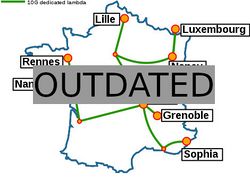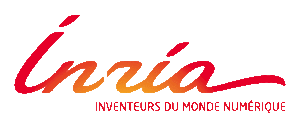Grid5000:Home: Difference between revisions
No edit summary |
No edit summary |
||
| Line 7: | Line 7: | ||
Key features: | Key features: | ||
* provides '''access to a large amount of resources''': 15000 cores, 800 compute-nodes grouped in homogeneous clusters, and featuring various technologies: GPU, SSD, NVMe, 10G and 25G Ethernet, Infiniband, Omni-Path | * provides '''access to a large amount of resources''': 15000 cores, 800 compute-nodes grouped in homogeneous clusters, and featuring various technologies: PMEM, GPU, SSD, NVMe, 10G and 25G Ethernet, Infiniband, Omni-Path | ||
* '''highly reconfigurable and controllable''': researchers can experiment with a fully customized software stack thanks to bare-metal deployment features, and can isolate their experiment at the networking layer | * '''highly reconfigurable and controllable''': researchers can experiment with a fully customized software stack thanks to bare-metal deployment features, and can isolate their experiment at the networking layer | ||
* '''advanced monitoring and measurement features for traces collection of networking and power consumption''', providing a deep understanding of experiments | * '''advanced monitoring and measurement features for traces collection of networking and power consumption''', providing a deep understanding of experiments | ||
Revision as of 00:57, 12 February 2020
|
Grid'5000 is a large-scale and flexible testbed for experiment-driven research in all areas of computer science, with a focus on parallel and distributed computing including Cloud, HPC and Big Data and AI. Key features:
Grid'5000 is merging with FIT to build the SILECS Infrastructure for Large-scale Experimental Computer Science. Read an Introduction to SILECS (April 2018)
Older documents:
|
Random pick of publications
Five random publications that benefited from Grid'5000 (at least 2517 overall):
- Clément Courageux-Sudan, Anne-Cécile Orgerie, Martin Quinson. A Wi-Fi Energy Model for Scalable Simulation. WoWMoM 2023 - 24th IEEE International Symposium on a World of Wireless, Mobile and Multimedia Networks, Jun 2023, Boston (MA), United States. pp.1-10. hal-04055720 view on HAL pdf
- Cyrille Bonamy, Laurent Bourgès, Laurent Lefèvre. Impact des langages de programmation sur la performance énergétique des applications de calcul scientifique : un challenge ?. JRES 2022 - Journées Réseau de l’Enseignement et de la Recherche, RENATER, May 2022, Marseille, France. hal-03607468 view on HAL pdf
- Matthieu Pigaglio, Joachim Bruneau-Queyreix, Yérom-David Bromberg, Davide Frey, Etienne Rivière, et al.. RAPTEE: Leveraging trusted execution environments for Byzantine-tolerant peer sampling services. ICDCS 2022 - 42nd IEEE International Conference on Distributed Computing Systems, Jul 2022, Bologna, Italy. pp.1-11. hal-03923712 view on HAL pdf
- Tulika Bose, Irina Illina, Dominique Fohr. Transferring Knowledge via Neighborhood-Aware Optimal Transport for Low-Resource Hate Speech Detection. Asia-Pacific Chapter of the Association for Computational Linguistics and the 12th International Joint Conference on Natural Language Processing (AACL-IJCNLP), Nov 2022, Online, Taiwan. hal-03846693 view on HAL pdf
- Quentin Guilloteau, Bogdan Robu, Cédric Join, Michel Fliess, Éric Rutten, et al.. Model-free control for resource harvesting in computing grids. CCTA 2022 - Conference on Control Technology and Applications, CCTA 2022, Aug 2022, Trieste, Italy. 10.1109/CCTA49430.2022.9966035. hal-03663273v2 view on HAL pdf
Latest news
Failed to load RSS feed from https://www.grid5000.fr/mediawiki/index.php?title=News&action=feed&feed=atom: Error parsing XML for RSS
Grid'5000 sites
Current funding
As from June 2008, Inria is the main contributor to Grid'5000 funding.
INRIA |
CNRS |
UniversitiesUniversité Grenoble Alpes, Grenoble INP |
Regional councilsAquitaine |


